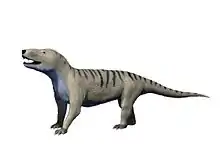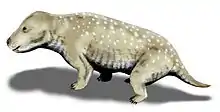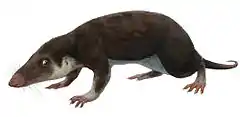Pseudotherium
Pseudotherium ("false beast") is an extinct genus of mammaliamorph cynodonts from the Late Triassic of Argentina. It contains one species, P. argentinus, which was first described in 2019 from remains found in the La Peña Member of the Ischigualasto Formation in the Ischigualasto-Villa Unión Basin.[1]
| Pseudotherium | |
|---|---|
.jpg.webp) | |
| Holotype skull of P. argentinus | |
| Scientific classification | |
| Kingdom: | Animalia |
| Phylum: | Chordata |
| Clade: | Therapsida |
| Clade: | Cynodontia |
| Clade: | Mammaliamorpha |
| Genus: | †Pseudotherium Wallace et al., 2019 |
| Species: | †P. argentinus |
| Binomial name | |
| †Pseudotherium argentinus Wallace et al., 2019 | |
Discovery and naming
The holotype and only known specimen, PVSJ 882, was discovered in 2006 by Argentine palaeontologist Ricardo N. Martínez during an expedition to the Ischigualasto Formation. It consists of a partial skull lacking the lower jaw, quadrate bones and most of the zygomatic arches and premaxillae.
The generic epithet Pseudotherium is derived from the Greek words pseudo, meaning "false", and therios, meaning "beast". The specific name argentinus references the country of Argentina where it was found.[1]
Description
Pseudotherium would have been a relatively large cynodont; excluding its missing premaxillae, the holotype skull is 69 millimetres (2.7 in) in length. Running along the top of the skull is a prominent sagittal crest, which would have served as an attachment point for large jaw muscles. Unusually for a mammaliamorph, it possesses remnants of the prefrontal and postorbital bones.[1]
The snout of Pseudotherium is long and slender. As the premaxillae are incomplete, no incisors have been preserved. The canines are thin and curved, with unique longitudinal ridges on each side. Behind the canines are nine pairs of postcanine teeth; these are separated from the canines by a short diastema. The postcanines resemble those of Botucaraitherium and the brasilodontids, possessing three main cusps in a roughly symmetrical arrangement. The seventh and eighth postcanines also bear two and three accessory cusps, respectively. Unlike in tritylodontids and mammaliaforms, the roots are incompletely divided.[1]
References
- Wallace, Rachel V. S.; Martínez, Ricardo; Rowe, Timothy (2019). "First record of a basal mammaliamorph from the early Late Triassic Ischigualasto Formation of Argentina". PLOS ONE. 14 (8): e0218791. doi:10.1371/journal.pone.0218791.







